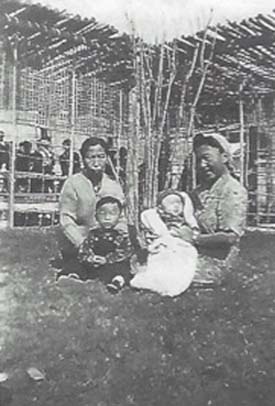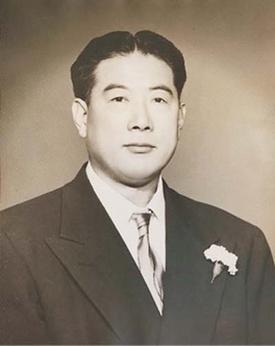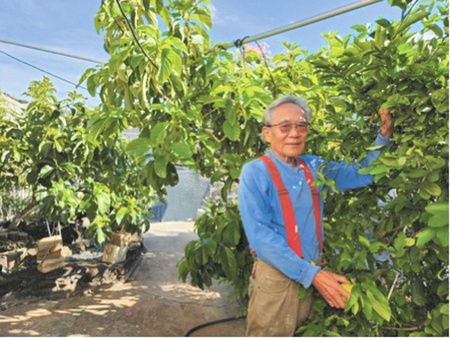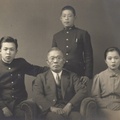“Kotonk” A Japanese American from the continental United States vis-à-vis a Japanese American from Hawai‘i. Originating from World War II-era conflict between Hawai‘i-born and U.S. mainland-born Japanese Americans in the 442nd Regimental Combat Team. Initially a pejorative term, “kotonk” is still used occasionally in Hawai‘i today. – Densho Encyclopedia
Writer’s note: Personally, I have tried to erase the term “kotonk” from my vocabulary. It is a term of my father’s generation and was often used in a negative connotation. I perceive it as a word of “separation” or “othering” creating a feeling of “us and them” and I think that the American Nikkei community should try to close the gaps that separate those of us from the Mainland and Hawai‘i. The use of the word “kotonk” in the article title was suggested by Earl Terao himself, so it appears here at his request.
Growing up here in Hawai‘i, I was like many “local” Nikkei quite unaware of the incarceration of almost the entire Nikkei community on the West Coast during the war. The signing of Executive Order 9066 by President Franklin D. Roosevelt on Feb. 19, 1942, authorized what was to become the forced removal and incarceration of all people of Japanese ancestry on the West Coast. Over 110,000 people, over two thirds of whom were American citizens, were affected.
In recent years, I have sought to learn about this dark period in American history when the hysteria and fear of war generated by the Japanese attack on Pearl Harbor created an environment where citizens’ human rights and dignity were forcefully and wrongfully denied by their own government. I have discovered that many Nikkei friends that I assumed were local were actually transplants from the Mainland, many of them moving to Hawai‘i to escape the racism they experienced there. It’s always an eye-opener when I learn their true origins.
The Japanese on the West Coast were given just a few days to collect belongings (limited to two suitcases per person), close their farms and businesses and sell their personal items before reporting to several collection centers where they stayed for several months until they were relocated to hastily constructed camps in remote and desolate areas inland. They were often only able to sell their furniture and equipment for pennies on the dollar if they got anything at all and lost most of their accumulated wealth.
Here in Hawai‘i, only the leaders of the Japanese community were incarcerated and then, only the family heads, not the entire families. The large majority of local Nikkei with roots on the plantations didn’t experience the trauma of dislocation, loss of freedom and isolation that the Mainland Nikkei did. Additionally, many of the families that did have family members who were incarcerated felt shame and would not talk about the experience even when they had done nothing to justify the treatment.
I hope to write a series of articles about Nikkei living in Hawai‘i that have a connection to the incarceration and share it with The Hawai‘i Herald audience so that we can all become more aware of what the experience meant to their families.
I recently met Terao a few years ago and found his personal life history very interesting. Born in an internment camp during World War II, he later grew up in the Los Angeles area and eventually moved to Honolulu where he has lived for almost 50 years. This is his story.
* * * * *
The Terao Family Internment Experience
Earl Terao’s parents, father Shinichiro “Terry” Terao and his wife, Tomiko, owned a small corner grocery store and lost everything when they were incarcerated at the outset of the war. The unfairness of their personal economic hardship and loss of freedom during the incarceration embittered them for many years after the war against the U.S. government.

The elder Terao was born in 1908 in the plantation village of Papaloa on the Hämäkua Coast of the Big Island. When his father, Toyotaro, died in 1920, his mother returned to Japan with her 10 children. He was educated in Japan and attended the prestigious Keio University in Tōkyō.
As a young man growing up in Japan, he experienced discrimination because he was an American citizen and his uncle Yokotake, who was a member of the foreign ministry, advised him to return to America advising that his opportunities would be greater there. Yokotake may have also anticipated that war was on the horizon given his position in Japan’s foreign service.
Like many Los Angeles residents, the Teraos were ordered to report to the Santa Anita racetrack where they were quartered in a former stable. Years later, Earl Terao remembers his mother’s memories about the horrible stench of the horse manure and urine that permeated the stable, where she would give birth to his oldest brother, Emery.
Earl was born in 1943 in the Poston internment camp in Arizona where the family was assigned. While just an infant during their incarceration, he recalls his mother’s experience about the unrelenting heat, dust storms that got sand into everything and the severe lack of privacy since families shared a barrack building with only cloth sheets serving as a makeshift wall dividing families.
The Loyalty Oath
In 1943, the War Department and the War Relocation Authority jointly created a bureaucratic means of assessing the loyalty of Nikkei in the WRA concentration camps. All adults were asked to answer questions on a form that became known informally as the “loyalty questionnaire.”
Question number 27 asked if Nisei men were willing to serve on combat duty wherever ordered and asked the women if they would be willing to serve in other ways, such as serving in the Women’s Army Auxiliary Corps. Question number 28 asked if individuals would swear unqualified allegiance to the United States and forswear any form of allegiance to the emperor of Japan. Many respondents resented Question number 28 because they were being asked to renounce a loyalty to the emperor of Japan to whom they had never held a loyalty to in the first place.
As a highly educated individual, Terry Terao was acutely aware of the violation of his civil rights during the incarceration and also harbored resentment towards the U.S. government. He responded, “No” to both questions and faced the ire of many of the so-called “loyal Americans” in the camp. Many years later, the “No-No Boys,” as they were known, were recognized as being within their rights to refuse to serve in the military of a country that had violated their civil rights in such an egregious manner.
Life After the War
Immediately after their release from the camp, the family spent some time in Visalia, in Central California, living with an aunt and uncle who owned a farm. After accumulating some savings, they relocated to Gardena, a suburb of Los Angeles. There was a large Nikkei community and his father felt it important for the four Terao boys to retain some of their Japanese culture.
Terry Terao raised his sons with what would be called “tough love” today. He would justify this to them by explaining “I’m raising you boys so that you won’t have problems when you go into the military or have tough bosses in the future.”
The Teraos, like many other Nikkei families, faced continuing racial discrimination after the war. Terry Terao passed away from colon cancer in 1960 at age 52 leaving behind a wife and four sons, ages 13 through 17. His widow raised her four sons with the help of her mother and worked at Honeywell electronics near their home to support the family.
In homage to his mother, Tomiko, Earl Terao says that she was able to fulfill her husband’s long-term goals of owning rental properties through hard work and wise investments. He feels that her positive attitude and hard work gave hope to him and his brothers for a better life.
She passed away in January 2017, just four months short of reaching 100 years of age.
“Join the Navy, See the World”
This slogan from an old Navy recruiting poster held true for Earl. After graduating from high school in 1961, he attended a junior college for a year and then the UCLA Dental Technician School. In 1968, to avoid being drafted, he enlisted in the Navy and became a dental technician on a repair ship known as a destroyer tender, serving in various ports in the Far East during the Vietnam War.
On his ship’s trip from the Long Beach Naval Station to the Western Pacific, Terao recalls a stop in Pearl Harbor where he felt very comfortable for maybe the first time in his life, blending into the local Asian community. He vowed to return some day.
After completing his enlistment, he left the Navy in 1970 and entered the profession of making dental prosthetics.
Finding Paradise
Fast forward a few years. Terao’s work for a large dental supply company brought him to Honolulu several times. He worked with many in the local dental community and became more familiar with the local scene. In 1976, he received an offer to become a partner in a local dental lab. He relocated to Honolulu and found that he enjoyed the life here much to his liking; the people, the food, the abundance of Asian culture. A very significant contributor to this feeling of comfort was the large Asian population where he could blend in without feeling like a minority.
Earl recalls, “When I first moved to Hawai‘i with my L.A. accent, many locals would ask ‘Where are you from?’ to which I would reply, ‘I’m a kotonk.’ They would say, ‘Oh, no wonder you talk like that.’” Through this self-identification, he eventually became comfortable with the label.
He later married his wife, Cindy, the daughter of a 100th Infantry Battalion Nisei veteran of World War II. They have two daughters and Earl has two other children from a previous marriage.
During breaks from renovation projects on his home in Pälolo Valley, Earl would find time to “talk story” with Cindy’s father, Masaru Fujiwara, about his experiences during the war. Somehow, the shared bond between the military veterans from two different wars encouraged his father-in-law to speak about his experiences, which Earl learned later he had never shared with his own children.
Ironically, the son of a “No-No” respondent learned about the experiences of a Nisei veteran who fought for his country to prove his loyalty when it was questioned by his government. Through this unusual happenstance, Earl has seen both sides of the Nikkei story of World War II and how they shaped the lives of those that lived through that experience.
Terao is currently happily retired and grows fruit and vegetables in his yard that he shares with friends and family.
His story is one example of how the different experiences of the Hawai‘i and Mainland Nikkei during the war created a large disparity in our personal lives. If you are interested in learning more about the Japanese incarceration during World War II, I highly recommend visiting the website of Densho (densho.org), a non-profit based in Seattle that is dedicated to telling the story of the incarceration and inspiring people to prevent such discrimination from happening again.
By learning about what happened to the Nikkei on the Mainland, we can appreciate how the incarceration affected their families for generations and gain a greater understanding and empathy for what they went through; and in some cases are still experiencing. Through this process, perhaps the term “kotonk” will disappear from our language and we can become more like one community.
In the meantime, Earl will continue enjoying his own paradise that many of us take for granted. Lucky we live Hawai‘i.
* This article was originally published in The Hawai‘i Herald on December 2, 2022.
© 2022 Byrnes Yamashita









